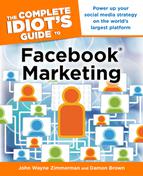Fans
The term “fans” is one of the biggest misnomers in Facebook. Conjures up images of Justin Bieber–singing teenagers, doesn’t it? The funny name probably came about because Fan pages were originally built for musicians, actors, and other celebrities. As Facebook expanded, it realized that companies were interested in Fan pages, too.
Understanding the Power of Fans
If friends are the one-on-one conversation, fans are the megaphone to the masses.
Here are some facts about fans:
• Individuals can’t have fans unless they create a Fan page.
• Your actions show up in your fans’ News Feeds, but your fans’ actions don’t show up in yours.
• Fans can comment on your page.
| FEEDBACK |
If you want anyone to comment on your page, not just fans, then go to the Options menu and you can choose who can post on your fan Wall, with options ranging from “anyone,” “fans,” and “no one.”
Unlike friend-based pages, with a Fan page you can connect with your customers with more control over what is posted on your page.
Fan-based business pages are much more common for businesses, especially among larger, more corporate businesses such as the following:
• A chamber of commerce
• A Fortune 500 company
• A large law firm
They tend to be more formal and focused more on getting a particular message or piece of knowledge out rather than having one-on-one conversations with customers.
Calculating a Fan’s Worth
When it comes to determining a fan’s worth, the argument is as heated as religion and politics. Estimates vary widely, with three different companies specializing in this kind of thing estimating the worth at anywhere from $3.60 to $136.80 per fan. The disparity is pretty amusing—unless you’re the one in charge of the marketing budget.
The amount you want to spend on getting additional fans really depends on your business. If you are selling $2 ice cream cones, the amount you’re willing to spend is probably much lower than if you sell luxury goods.
| FRIENDLY ADVICE |
Facebook launched its new feature, Timeline, in late 2011. It gives you a visual representation of your history on Facebook.
How can it be valuable to your business? It actually tracks all the events that have happened on your Facebook page—including when people unfriended you, stopped liking your page, and other details. Much of this information has been available to you already, as we will discuss in Chapter 16 on analytics, but with Timeline, Facebook has made tracking your daily, monthly, and even yearly changes more user-friendly.
For more information on Timeline, go to www.facebook.com/about/timeline.
It also depends on how you make your money. Think about Zynga, the über-popular social gaming company behind FarmVille and Mafia Wars. Zynga makes its money on ads as well as small in-game purchases. Getting another fan increases the number of people viewing the ads, and the more viewers it has, the more money it can charge for its ads.
| FRIENDLY ADVICE |
The Zynga business model totally transformed how companies market their business and make a profit on Facebook. See Chapter 13 for more on games.
Follow these steps to figure out how much you should spend per fan:
1. Figure out how much the average customer spends during the course of his or her relationship with your business.
2. Determine how many customers are being referred to you through Facebook.
3. Weigh in other social and traditional media, comparing the price per new customer to the cost of Facebook customers.
4. Decide what portion of your marketing budget Facebook merits.
